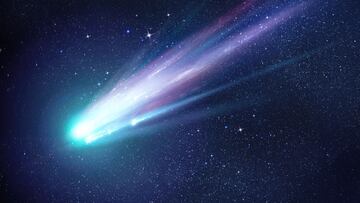When will the hyperbolic comet Nishimura be visible? The best dates and times to see C/2023 P1
A recently discovered comet is racing through the solar system and will be visible from Earth for a limited time. Here’s how to catch a glimpse of Nishimura

On the enormous canvas of the sky, a cosmic visitor is leaving its luminous mark: the comet C/2023 P1, also known as Nishimura, named thus by the surname of its discoverer, Hideo Nishimura of Japan, an amateur astronomer.
With their bright and fleeting presence, comets have always captured our imagination, and this one in particular is no exception. As it passes through the solar system, Nishimura provides us with a unique opportunity to observe a celestial phenomenon that connects our planet to the vastness of outer space.
As Comet Nishimura approaches, many astronomy enthusiasts are wondering when they will be able to enjoy its show in the night sky. Comet-watching conditions may vary, but in the case of this comet, it is expected to be visible in the northern hemisphere, including the United States.
The duration of its visit will be quite brief, largely due to the gravitational intervention of the sun, which will repel the astral body as soon as it approaches it.
Track the trajectory of comet Nishimura as it traverses the Solar System during August-September 2023 ☄️ By September 11, this comet is expected to be observable without the aid of a telescope. Visit our website for further information regarding this celestial phenomenon! #Comet pic.twitter.com/hmdgbFhvvt
— Byte Blast (@Byte_blast) September 1, 2023
Is this the first time Nishimura has made a trip around the Sun?
Some experts have come to the conclusion that Comet Nishimura is classified as a non-periodic comet, which implies that its approach to our planet is an unusual event.
Its extensive journey through deep space, with its origin possibly anchored in the mysterious Oort cloud, traces a journey that spans millennia. Theories hold that this could be its first significant approach to Earth, a factor that adds a touch of fascination to its presence in the skies.
What does it mean that it is a hyperbolic comet?
Because it is a hyperbolic comet, this is a special type that has a highly eccentric orbit and is not gravitationally bound to the solar system, in addition to having trajectories so extremely elongated that they only pass through the solar system once before being ejected outward. interstellar space.
September 13 will mark a crucial milestone, when the comet will come within roughly 78 million miles of Earth, and will be able to be seen thanks to the fact that it will enter the orbit of Venus. This moment promises to give us an exciting spectacle in the skies.
See bright Comet Nishimura at dawn.
— Con Stoitsis (@vivstoitsis) September 4, 2023
Finder chart below. pic.twitter.com/CMRiPk4dPM
The best days and times to see Comet Nishimura
According to the website Starwalk, Comet Nishimura reaches magnitude 4.8 this September 8. That is, it will be bright enough to be seen with the naked eye. The comet will be visible a few hours before dawn in the constellation Leo, and also at dusk.
It will also be visible between September 12 and 21, however, those in the northern hemisphere will probably lose sight of it after 13 September accroding to The Planetary Society. It will become brighter as it gets closer to the Sun, reaching its perihelion 17 September, but this will also make it difficult to observe.
Related stories
The best times to see it are before dawn and at dusk, as long as there are clear skies. If you need help finding Nishimura in the sky, Space.com provides a list of some stargazing apps that could be of use.
This astronomical event gives amateurs and the curious alike the opportunity to marvel at the beauty and transience of celestial bodies in motion. Whether with telescopes, binoculars or simply with the naked eye, comet C/2023 P1 reminds us of the fascinating and dynamic nature of the universe around us.

